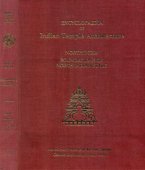Vatsagulma: 4 definitions
Introduction:
Vatsagulma means something in Hinduism, Sanskrit, the history of ancient India. If you want to know the exact meaning, history, etymology or English translation of this term then check out the descriptions on this page. Add your comment or reference to a book if you want to contribute to this summary article.
In Hinduism
Kavya (poetry)
Source: Shodhganga: The Kavyamimamsa of RajasekharaVatsagulma (वत्सगुल्म) is the name a locality mentioned in Rājaśekhara’s 10th-century Kāvyamīmāṃsā.—In the Karpūramañjarī (act. I), Rājaśekhar say Vatsagulma is a city in the country of Vidarbha. Which may identified with the name Vamsagulma in the Mahābhārata and from this place the river Narmadā rises. So it is possible that, it may be situated in the Vidarbha country. However, Vātsyāyaṇa in his Kāmasūtra mentions one Vatsagulmaka, which is different from this from the Vidarbha.

Kavya (काव्य, kavya) refers to Sanskrit poetry, a popular ancient Indian tradition of literature. There have been many Sanskrit poets over the ages, hailing from ancient India and beyond. This topic includes mahakavya, or ‘epic poetry’ and natya, or ‘dramatic poetry’.
Shaktism (Shakta philosophy)
Source: Google Books: ManthanabhairavatantramVatsagulma (वत्सगुल्म) refers to one of the nine disciples of Siddhanātha, according to the Manthānabhairavatantra, a vast sprawling work that belongs to a corpus of Tantric texts concerned with the worship of the goddess Kubjikā.—Vatsagulma appears in the later scheme as the second of the Sixteen Siddhas. Three verses are dedicated to him:—Vatsagulma became an elephant called Mada who, hard to control, was like a mountain peak. Those who recollect the initiates who possesses genuine devotion at the three times of the day and shine as the Krama teachers, easily enter into the universal cause which is incomparable expansion (prasara).
Note: Vatsagulma is the place of origin of the Vākāṭakas who ruled in the Gupta period (320-600 CE) over a large area of central India. It has been identified with a town called Vashim in the Akola district.

Shakta (शाक्त, śākta) or Shaktism (śāktism) represents a tradition of Hinduism where the Goddess (Devi) is revered and worshipped. Shakta literature includes a range of scriptures, including various Agamas and Tantras, although its roots may be traced back to the Vedas.
India history and geography
Source: archive.org: Geography in Ancient Indian inscriptionsVatsagulma (वत्सगुल्म).—The Bashim grant of Vindhyaśakti II as well as India Office Plate of Devasena mention the city Vatsagulma or Vatsyagulma. It is probably identical with Bashim the chief town of the Washin taluq of the Akola district in Maharashtra. Bashim lies on the Khandwa-Purna section of the central railway. It is one hundred six kilometres from Akola and situated between Ajanta Rangeand the river Pengaṅgā. It is regarded as a holy place. As manyas one hundred eight Tīrthas associated with different Gods and sages are said to be there at this place. Sarvasena chose Vatsagulma as capital of his separate Vākāṭaka kingdom.
The Kāmasūtra of Vātsyāyana mentions Vatsagulmakas, the people of Vatsagulma. The Jayamaṅgalā commentary on the Kāmasūtra gives some information about the derivation of Vatsagulma, the name of a country. According to this commentary, the country was known as Vatsagulma. because the two princes of Dakṣiṇāpatha, Vatsa and Gulma, had settled it.
In the local Māhātmya, however, it is stated that a sage Vatsa by his severe austerities made an assemblate (gulma) of the gods come down and settle in the vicinity of his place of residence, which since then came to beknown as Vatsagulma. The Importance of Vatsagulma as a centre of culture is suggested by Rājaśekhara. In his rhetorical work Kāvyamīmāṃsa (third chapter), the mythical Kāvyapuruṣa is said to have married the sāhitya-vidyādharī at Vatsagulma in Vidarbha, which is the pleasure-resort of the God of Love.
Source: What is India: Inscriptions of the VākāṭakasVatsagulma (वत्सगुल्म), which was evidently the capital of this branch (of the Vākāṭaka family), is undoubtedly modern Bāsim where the plates were discovered. The place-name is variously derived. The Jayamaṅgalā, a commentary on the Kāmasūtra, states that Vatsa and Gulma were two uterine brothers and princes of Dakshiṇāpatha. The country settled by them came to be known as Vātsagulmaka.
The local Māhātmya gives an altogether different derivation. It states that Vatsa was a sage who by his very severe austerities made an assemblage (gulma) of gods come down and settle in the vicinity of his hermitage. Both these derivations are evidently conjectural. The Vātsagulmaka country is mentioned in the Kāmasūtra of Vātsyāyana which describes some peculiar customs current there. Vatsagulma is also mentioned by Rājaśekhara in his works Karpūramañjarī and Kāvyamīnāṃsā.

The history of India traces the identification of countries, villages, towns and other regions of India, as well as mythology, zoology, royal dynasties, rulers, tribes, local festivities and traditions and regional languages. Ancient India enjoyed religious freedom and encourages the path of Dharma, a concept common to Buddhism, Hinduism, and Jainism.
See also (Relevant definitions)
Full-text: Sarvasena, Vishrutacarita, Pravarasena, Vatsagulmi, Vacchomi, Rajya, Pravira, Harivijaya.
Relevant text
Search found 2 books and stories containing Vatsagulma; (plurals include: Vatsagulmas). You can also click to the full overview containing English textual excerpts. Below are direct links for the most relevant articles:
Kavyamimamsa of Rajasekhara (Study) (by Debabrata Barai)
Part 2.6 - Marriage of Kāvya-puruṣa with Sāhitya-vidyā-vadhū < [Chapter 5 - Analyasis and Interpretations of the Kāvyamīmāṃsā]
Part 23 - The story of kāvya-puruṣa by Rājaśekhara < [Chapter 2 - A General Outlines of Sanskrit Poetics]
Appendix 2 - Identification of Geographical names mentioned in the Kāvyamīmāṃsā
The Padma Purana (by N.A. Deshpande)
Chapter 14 - Chopping-off of Brahmā’s head by Rudra < [Section 1 - Sṛṣṭi-khaṇḍa (section on creation)]
Related products
